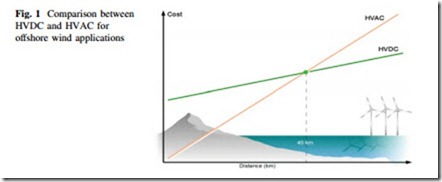Abstract Large-scale wind energy expansion is limited by factors such as the land use and the visual impact of facilities on land. Offshore wind energy can overcome the above-mentioned limitations. In addition, wind velocity is higher and more constant offshore than onshore. This chapter will present an overview of different topologies for grid integration of offshore wind farms. Special emphasis is made on the offshore grid topologies and types of power electronic converters.
Keywords Offshore wind energy HVDC transmission Offshore grid Line-commutated converters Voltage source converters Modular multilevel converters
Introduction
Nowadays, the two main challenges in the energy sector are to assure the energy security and to meet the environmental goals [1]. In the recent years, many countries have prioritized the use of renewable energy sources on their agenda in order to ensure the energy security while helping to preserve our environment [2].
Among renewable energy sources, wind energy is highlighted because of its enormous development in the last years. Nowadays, wind energy can be categorized as a mature technology, but the large-scale expansion is limited by factors such as the land use and the visual impact of facilities on land. The development of the offshore wind energy industry can overcome the above-mentioned limitations. Moreover, offshore wind resources are abundant in some regions and in general, wind conditions are better offshore than onshore, i.e., the average wind speed is higher and less turbulent. However, offshore installations are more costly com- pared to onshore facilities. The unit cost of energy can be decreased by increasing the rating and efficiency of offshore wind farms (OWFs), and hence, most of the research in the field is related to these two aspects. For these reasons, one of the greatest challenges is the transmission of large amounts of energy over long distances [3].
For interconnecting the wind farms there are two alternatives: high-voltage alternating current (HVAC) and high-voltage direct current (HVDC) [3, 4]. Today, HVAC is chosen in most of the projects located at a relatively short distance to the shore [4]. HVAC has an important limitation, the HVAC cables. This type of cables has a high capacitance per length, so in addition to the delivery electrical current, there is a capacitive current. This capacitive current is fluctuating every half cycle, and is utilizing part of the total current delivery capability. In other words, HVAC long cables require excessive reactive power [5]. This reactive power can be absorbed by using reactive shunt compensation, but this is at the expense of the investment and operating costs [5]. For offshore applications, HVDC becomes a more attractive solution in terms of investment and operating costs as the distance from the shore increases. The break-even point between HVAC and HVDC may vary from 60 to 100 km [6].
Currently, there are two HVDC technologies available in the market: LCC- based HVDC and VSC-based HVDC. LCC uses thyristors, which are line com- mutating devices, whereas VSC uses insulate-gate bipolar gate transistors (IGBT), which are self-commutating devices [7]. Although the LCC is the most widespread HVDC technology around the world, most studies on the grid integration of OWFs have been focused on VSCs because of their beneficial features of the ability to have independent control of active and reactive power, an external commutating source voltage is not required for the proper operation, VSC is able to supply passive grids, and reduced footprint compared with LCC-based HVDC systems [8–11]. The use of LCC for grid integration OWFs has been briefly studied. It has been neglected mainly because of the large footprint, and the external commuta- tion voltage needed for its operation. However, LCC has the lowest power losses and the lowest cost among converters for HVDC. Moreover, LCC-based HVDC is very suitable for the transmission of bulk power, and its reliability and availability have been demonstrated for many years.
This chapter deals with configurations of HVDC systems on OWFs. Different technologies and topologies are exposed and analyzed from the stand point of losses and reliability. The chapter is organized as follows: in Sect. 2 the main challenges for offshore wind energy are presented. Next, in Sect. 3, different grid
topologies are exposed. After that, the type of converter more suitable for each topology is analyzed in Sect. 4. The main types of HVDC systems are presented in Sects. 5 and 6, followed by the new trends on HVDC systems in Sect. 7. A brief review of the cable technologies is presented in Sect. 8. Finally, conclusions are presented in Sect. 9.
